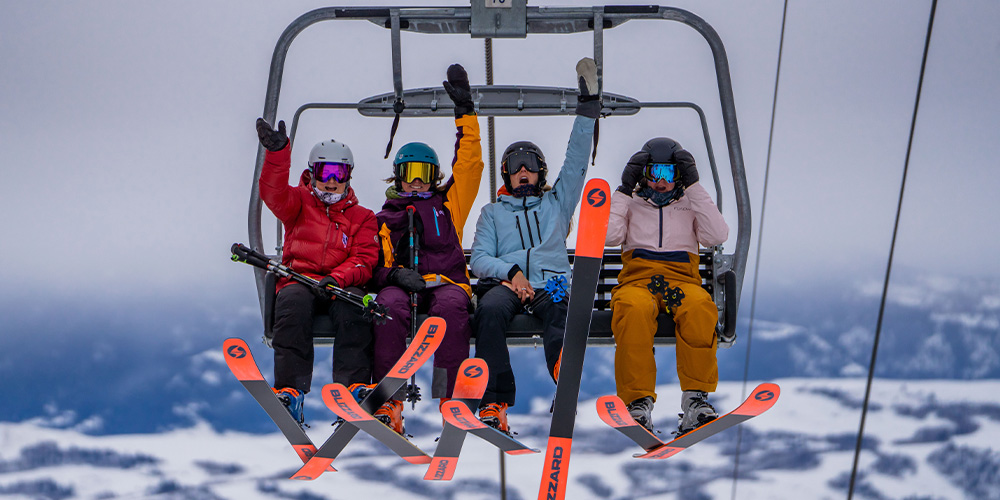 How To: Pack for Your Next Ski Trip
How To: Pack for Your Next Ski Trip
Skiing Essentials: How to Pack for Your Next Ski Trip
Posted
by
Skis.com
on Monday, December 18, 2023
A comprehensive gear guide for your first day out on the slopes.
Skiing is a fun way to experience the outdoors and explore new and beautiful places. Whether it’s you’re a first-time skier or planning your next family vacation, use this guide to ensure you don’t forget anything and are prepared with all the gear you need for a fun time at the mountain!
Check out this printer-friendly PDF of our Ski Trip Checklist to use as your packing:
Ski Trip Checklist (PDF)
Clothing
Dressing warm is key to making your day on the slopes enjoyable for you and your whole family.
Base Layer:

Layering is key to staying warm in the cold. Start with moisture-wicking underwear and base layer tops and bottoms. Base layers are the layers closest to your skin, so it is important to choose ones that will keep you warm, dry, and comfortable all day long.
Moisture-wicking layers, such as merino wool or synthetic blends, are great options that will move any moisture away from your skin to help keep you dry.
Insulated Mid Layer:
The next layer is an insulated mid layer to help trap and circulate heat. This could be a down jacket, synthetic down vest, or fleece quarter zip, for example.
Waterproof Outer Layer:
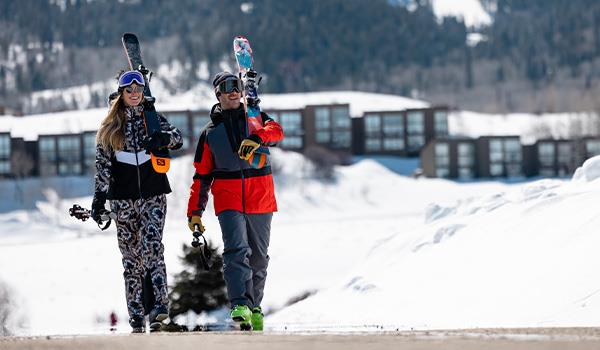
Finally, complete the look with a waterproof ski jacket and pants to protect against snow and wind. A bib may also be a good option as it provides a little more warmth to your core and extra snow protection.
Some outer layers are insulated while others may just be a shell without any insulation. Choose what’s best for you based on your current layers and the weather conditions you’ll be skiing.
Socks:
A good pair of ski socks can make a big difference out on the slopes! Ski socks provide light compression and are designed to be longer than regular socks so that they can come up above your ski boots.
Look for socks that are moisture-wicking (like base layers), such as those made out of merino wool or a synthetic blend. These will keep you warmer and are more breathable than regular socks.
Mittens and Gloves:
A solid pair of waterproof gloves or mittens are important. Mittens do a great job at keeping your hands warm by having most of your fingers in the same compartment, while gloves give you more dexterity.
If you take off your gloves and mittens often to help the kids or just need a bit more warmth, try wearing a thin glove liner under your mittens or gloves.
Neck warmers and face masks:
Neck warmers and face masks also help keep wind and snow off your face and provide warmth. There are a lot of different options and thicknesses of neck warmers and face masks.
Apres Ski Clothing:
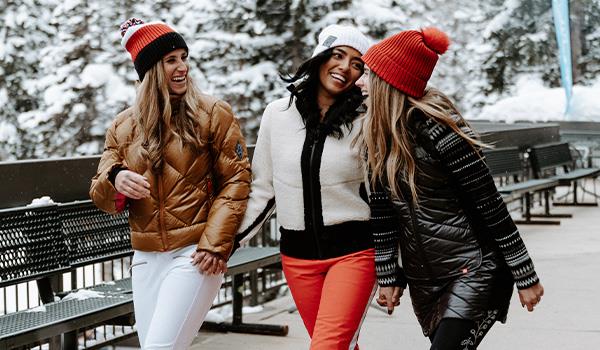
After the ski day is over, don’t forget to pack casual clothes you can relax in and enjoy apres-ski activities. Remember a warm jacket, a hat, ear warmers, scarf, and casual snow boots to walk around town.
Equipment
Choosing the right equipment is important to having a fun and safe time on the mountain.

Skis, Ski Boots, Ski Poles:
While rental options are available at many ski resorts, investing in skis, boots, and poles can be beneficial in the long run. Consult with a professional or experienced skier to determine the right skis for your skiing level and the terrain you’ll encounter.
Helmet and Goggles:
A proper-fitting helmet and goggles are essential to having a good time on the slopes and keeping you safe. Together, they also provide warmth and protection from wind, snow, and UV rays.
Ski Bag:
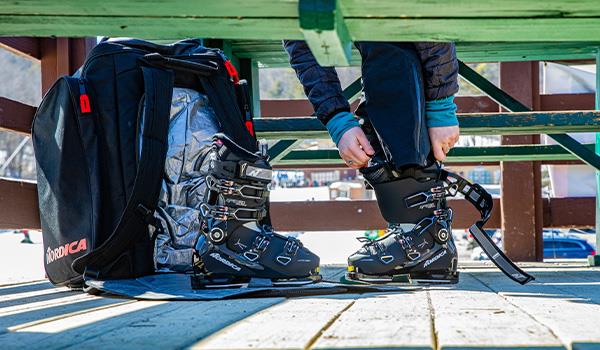
A ski bag and boot bag are important when flying with your equipment, but they can also be useful for carrying and protecting your equipment to and from the mountain. Ski bags and boot bags come in different sizes, so be sure to check your ski length and boot size when choosing ski and boot bags.
A small backpack can be useful to hold essentials like water, snacks, extra layers, and personal items while out skiing. Look for a bag with enough room to carry the things you'll need while skiing and small enough to comfortably wear all day.
Accessories
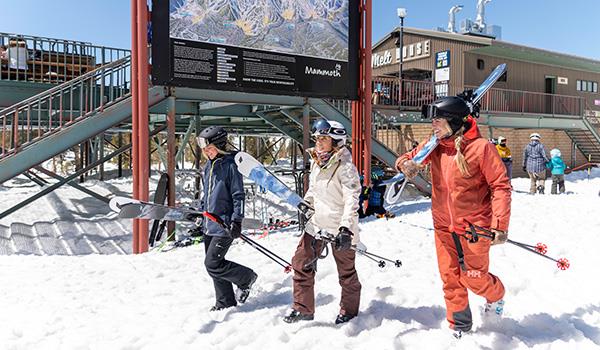
Now that you have your essentials locked down, here are a few more accessories that can be really useful to keep with you as you ski:
Sunscreen and Lip Balm:
While you’re out skiing, the sun reflects off the snow and can even cause sunburn. Look for products like lip balms and face sticks that contain SPF and protect exposed skin against sun and wind.
Hand and Toe Warmers:
Whether you use disposable or rechargeable warmers, having hand, toe, and bodywarmers can provide even more warmth and comfort on cold days.
Other

Wax for Skis:
If the bases of your skis are looking a little dry, a rub-on wax or liquid wax can be a quick fix on your trip. A rub-on or liquid wax does not require extra tools and is small enough to throw in your bag or pocket while at the mountain.
If you are renting skis or using your brand new skis for the first time, you won't have to worry about waxing your equipment. The rental shops will take care of all your equipment needs to have them ready to go when you rent and brand new equipment comes ready to go with factory wax.
Ski Lock:
Secure your equipment at the equipment racks with a ski lock while you go into the lodge for lunch or a quick bathroom break. Taking the extra minute to lock your equipment will save you the headache of having lost gear. Skis locks are small to easily fit in your pocket and can deter equipment mix-ups and theft.
Boot Heaters:
Nothing is worse than waking up to wet boots from the day before. Boot heaters provide the proper amount of heat to dry out your boots and can even be used to dry your snow boots, other footwear, and gloves. Ski boots are made of plastic, so it is important not to expose them to too high of temps, such as near a fireplace, as this could melt the plastic.
Before You Go
Before you leave for your trip, look over the mountain's lift passes, trail map, and services offered.
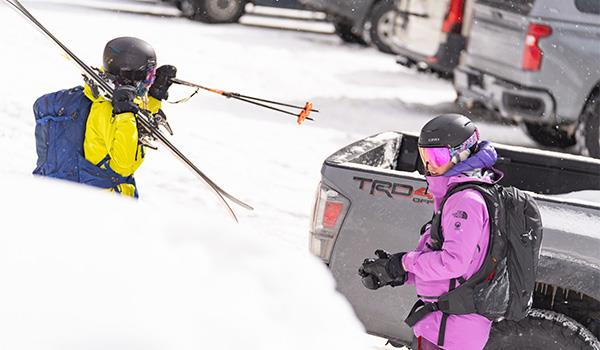
Lift Pass:
Whether you plan on purchasing lift passes ahead of time or at the ticket window, it’s a good idea to check the mountain’s website to find the most up-to-date information. At most mountains, passes can be purchased ahead of time to save you the hassle when you arrive and can sometimes be a bit more cost-effective than at the ticket window. Some mountains may require reservations, as well. Check the mountain's website so you can plan accordingly.
This is also a great time to check out the trail map and get yourself familiar with parking, lodge locations, and ski patrol info.
Take a Ski Lesson or Guided Tour:
For first-time skiers, enrolling in a beginner ski lesson is a great way to learn the basics and help build your confidence to help you have a fun and safe time on the snow.
Many resorts also offer guides for various skill levels to guide you around the mountain and explore new terrain. Check the mountain's website to learn more about they have to offer.
Ski Trip Checklist (PDF)
Categories:
Skills & Advice
Tagged: Ski Accessories, How To, Checklist, Packing List